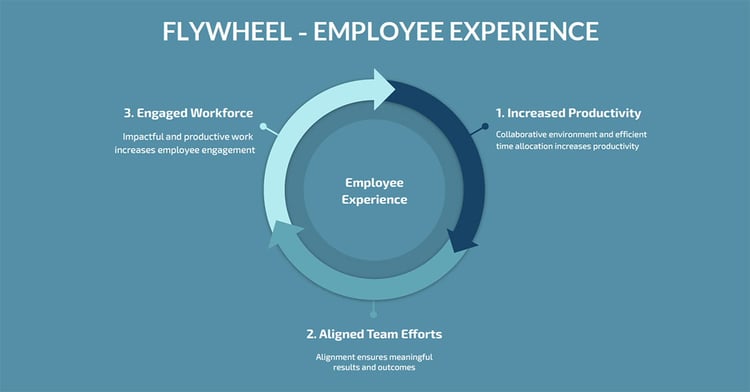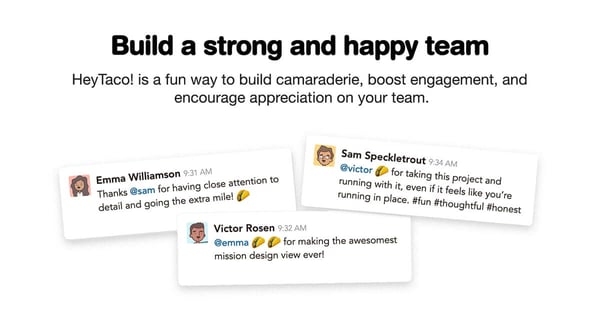Eliminating Silos: How Flowtrace Can Improve Cross-Team Collaboration
Eliminating silos improves collaboration, and productivity. Flowtrace helps you by providing metrics on collaboration, resulting in better...
The tech industry is a demanding space. Invest time in employee engagement strategies, so that you can retain your team and help them feel fulfilled.
The technology industry is known for its fast-paced and demanding nature, which can lead to high employee turnover rates. This can impact employee engagement, retention, and attrition, making it difficult for companies to maintain a stable and productive workforce. However, investing in employee engagement can help to mitigate these issues, leading to lower turnover rates, reduced costs associated with re-hiring, and improved productivity.
This article discusses the importance of employee engagement in the technology industry and provides strategies for leaders to increase engagement and improve the overall employee experience.
The tech industry can be a demanding place.
While we're drawn in by the ability to work virtually from anywhere with not much else than a laptop and good internet speed, the drawback is the constant need to stay engaged and switched on as an employee.
It's a fast-moving industry where new software, trends, and methods crop up regularly, far removing it from the regular 9-5 office job.
Employee turnover rates are high, impacting your employee engagement, retention, and attrition rates too.
Back in 2018, LinkedIn surveyed over a half-a-billion professionals who ranked Technology (software) as the industry with the highest turnover rates (13.2%), closely followed by Retail and Consumer Products (13%) and Media Entertainment (11.4%).
While the rate is mostly linked to increase in demand and opportunities in the space, UX/UI Designers, Data Analysts, and Engineers are even more likely to jump ship to pursue fairer compensation.
But not all companies, especially startups, can afford to pay industry-leading salaries and provide dreamlike perks and benefits.
So what can you do? Improve your employee engagement.
Companies that invest heavily in engaging their employees and improving their overall experience see lower turnover rates, reduction in costs linked to re-hiring, and less wasted efforts overall.
And while the Human Resources (HR) team can help, the leadership team is the one that needs to contribute the most.
In our guide, we cover the essentials and the five strategies for increasing employee engagement, so that you can retain your staff for longer and help them feel more fulfilled in their roles.
Let's dig in!
Employee engagement refers to the level of commitment and involvement an employee has towards their work and organization.
When employees are engaged, they're going to go the extra mile.
They'll quite often go beyond what their job role requires and become proactive, or even look outward to create meaningful connections in the industry to help drive the company forward.
Engaged employees are loyal and take ownership of the work that they do because they see meaning in it and feel their opinions are valued and taken into account.
And they are not as easily lured by new opportunities as someone who's disengaged or dissatisfied in their role.
The goal of engaging your employees could be seen as an assignment for your HR department, but it's the leadership teams that can (and should) make the biggest difference.
Even if you only take retention into account, it's worth your time.
Think of the resources and money wasted in recruiting, how painful it can be to replace someone who is your right hand, or how difficult it can be to build a whole team from scratch.
The HR team traditionally focuses on inclusion and diversity as well as improving the overall initiatives for learning and development. And while they'll see escalated cases when they crop up, they won't have deep insight into what employees are up to (or discouraged by) in their day-to-day.
Sadly, the HR team alone can't make a dent in the overall employee experience without leadership taking action to improve it holistically. It's the managers and leaders who track the real, everyday work, how it's produced, and its quality.
Alignment, purpose, and productivity all need to be taken into account to drive the employee forward.
Your team needs to do work that makes an impact: whether on the business, society, or any other measurable goal they're motivated by.
If your employees feel that their work matters and others support them in achieving their goals (instead of getting in their way), they will feel engaged!
Is employee experience the same as employee engagement? Not quite.
Employee experience refers to the overall journey of an employee within an organization, including their interactions with the company culture, management, and the work itself, and how it affects their perception of the organization and their job.
That said, focusing on engaging your workforce, increasing their productivity, and aligning them to business goals, can all contribute to creating a good (or bad) employee experience. Here's how we see employee angement at Flowtrace:

Jacob Morgan, author and keynote speaker, has described the differences between both terms quite well:
[The difference between employee engagement and experience is] the same as the difference between updating a car by just painting the outside and replacing the entire engine. One method makes the car look nice, but the other actually improves its performance.”
So while understanding, measuring, and facilitating good employee engagement is a goal for every leader, achieving a good employee experience is the ultimate objective for the business if you want to achieve more profits and scale faster.
You can see how Flowtrace helps to create stellar employee experience here.

If you want to improve employee engagement (as well as retention), you'll need to invest far earlier than handing the first major project to your new hire. The journey of an engaged employee starts with a proper introduction to your business.
It's been observed that 69% of employees are more likely to stay with a company for three years if they had a great onboarding experience, so you shouldn't underestimate the value of setting it up right.
But onboarding employees in a remote workplace could prove to be harder than ever before. You need to be ready to support your first new employees virtually - in some cases, it could be their very first time working remotely full-time.
In addition to creating a goal-oriented 30-60-90 day plan, it's useful to arrange for introductions with each of the team leads. These intros can show how different departments work together, emphasising how collaboration could happen in the future.
Another effective way of welcoming new hires remotely is to set up a buddy system.
Pick a volunteer - someone who's been at the company for a while, and ask them to check in with the new hire every week. New employees tend to open up more easily to their peers (not their superiors) and any initial bumps can be smoothened early.
Employees won't be fully engaged if they feel they're not being trusted.
We need to create a transparent work environment where access is freely given to all information: from making calendars public internally to providing visibility on overarching business goals and leadership team updates.
The future of work is increasingly remote, collaborative, and driven by technology, especially for knowledge workers. There's no room for mistrust or office politics when you're innovating!
One way to optimise the way we work and collaborate, is to actively measure how productive, collaborative, or successful we are.
But what makes us perceive “monitoring” employee behaviour bad or good? While it seems the line is extremely easy to cross, we believe it all comes down to how that information is used.
For example, there's a big difference between measuring the productivity of your team to improve together as a unit and screen capturing their desktops every 10 minutes.
Don't choose the latter or micromanage your employees if you want a good company culture. Keep your communication open, honest, and positive to kickstart meaningful conversations.
Ever started working on a project only to realise it was either already started by someone else, the information was outdated, or there was an obvious blocker?
All three are signs of information silos - the type of miscommunication you want to avoid. You can read what other impacts information silos have from here.
Employee engagement can take a nosedive when employees find out half-way through a project that the task at hand was already being done by someone else. To avoid the negative impact on productivity, you need to improve communication and visibility across your company.
It can be as simple as limiting private conversations or rather, leading by example and having public conversations where all stakeholders have visibility. Increasing the use of your project management tool can be helpful too.
Remember: Outdated information can lead to a lot of wasted effort. Producing half-baked deliverables on incomplete requirements can be equally damaging to morale.
Do you want to take a scientific approach in understanding your employee engagement? Increase your staff retention, re-engage your employees, and improve employee onboarding with insights from our collaboration analytics tool, Flowtrace.
Feeling recognised at work and knowing that professional growth is possible can both prove crucial to retaining your employees and making them feel excited about work.
According to the Global State of Employee Engagement Report, 63% of employees feel like they don't get enough praise. While "[o]rganisations with recognition programs which are highly effective at enabling employee engagement had 31% lower voluntary turnover than organisations with ineffective recognition programs.”
It makes sense.
When employees feel that the work they do matters, it becomes a massive driver for employee engagement. Employee turnover is expensive and resource-heavy, so the extra moment you take to appreciate the work your team does can be priceless.
While recognising personal achievements in 1-1s and peer feedback sessions is important, see if there's anything you can do to appreciate the work your team does in real-time.
If you use communication tools like Slack or Microsoft Teams, consider adding the peer recognition app, HeyTaco! to your tech stack. It's a fun app that helps celebrate team achievements with virtual appreciations and rewards.

Image credit: HeyTaco! Slack app homepage
Just because we don't see each other in person is no excuse to overlook employee well-being. You need to learn how to identify people at risk of burnout, especially for fully remote employees.
Did you know employee burnout can be caused by over collaboration? There are many reasons why your team could be feeling down:
To make things even more difficult, we're facing more extreme remote working and confinement in our makeshift home offices, and the morale is low. So how can you lead effectively when you and your team are exhausted? And how can you keep your team motivated through it all?
Quoting the brilliant article by Harvard Business Review, there are many ways how you could energise your team:
Sharing success stories, setting up competitions, dividing long projects into sprints, communicating. But also shortening endless zoom meetings, cutting tumbleweed projects, and allowing constructive conflicts and honest feedback in your teams.
How you do it matters less. That you do it matters immensely.
We're all exhausted right now.
— Flowtrace - Collaboration Analytics Tool 📊🤝 (@FlowtraceLtd) January 28, 2021
As a leader, you can energise your team by:
🏅 Sharing successes
🏃 Dividing long projects into sprints
📞 Shortening Zoom meetings
✂️ Cutting tumbleweed projects
👥💬 Allowing for honest feedback#leadership @HarvardBizhttps://t.co/7KCEpYI91P
Increasing employee engagement starts with caring for your employees and helping them see the importance of the work that they do.
As a leader, you need to step up, join forces with your team (including HR), and deploy a range of different strategies to improve the overall culture at work.
When your team feels valued, they'll be more inclined to stay and do their best.
So if there's anything you can do today to make your team members feel appreciated - do it!
Even a small note could make someone's day and engage them in a completely new way.
We hope you enjoyed reading this article. If there are any employee engagement tips we missed, please let us know in the comments!
You can learn more about how Flowtrace helps your teams feel engaged from here:
Eliminating silos improves collaboration, and productivity. Flowtrace helps you by providing metrics on collaboration, resulting in better...
Discover how to measure and improve company culture using metrics, recommendations, and benchmarks for a data-driven approach to a successful...
Discover how to improve team communication and increase efficiency with clear guidelines, collaboration tools and surveys.